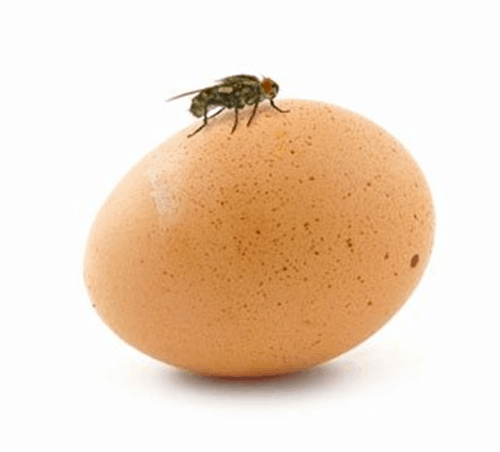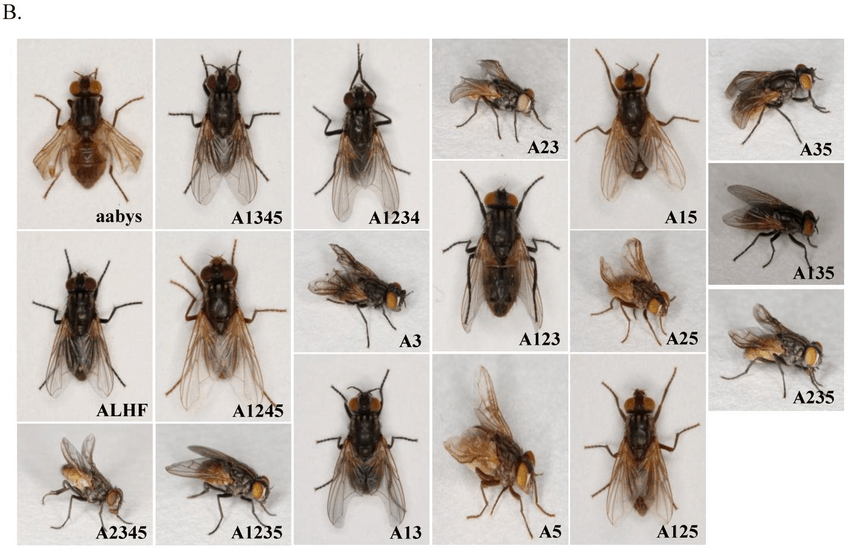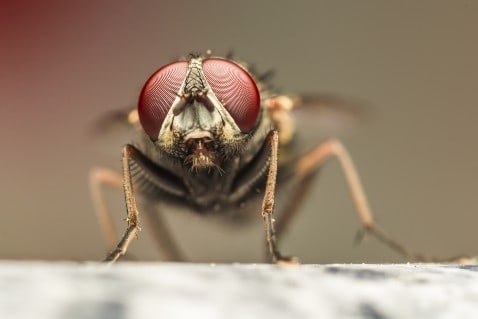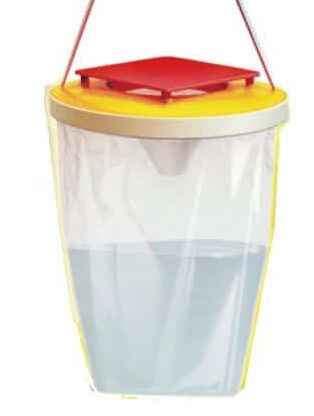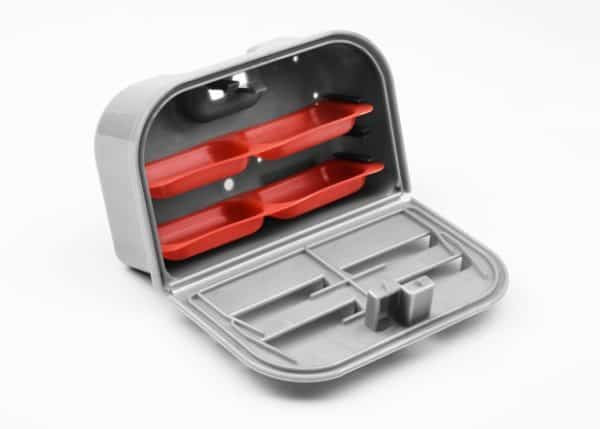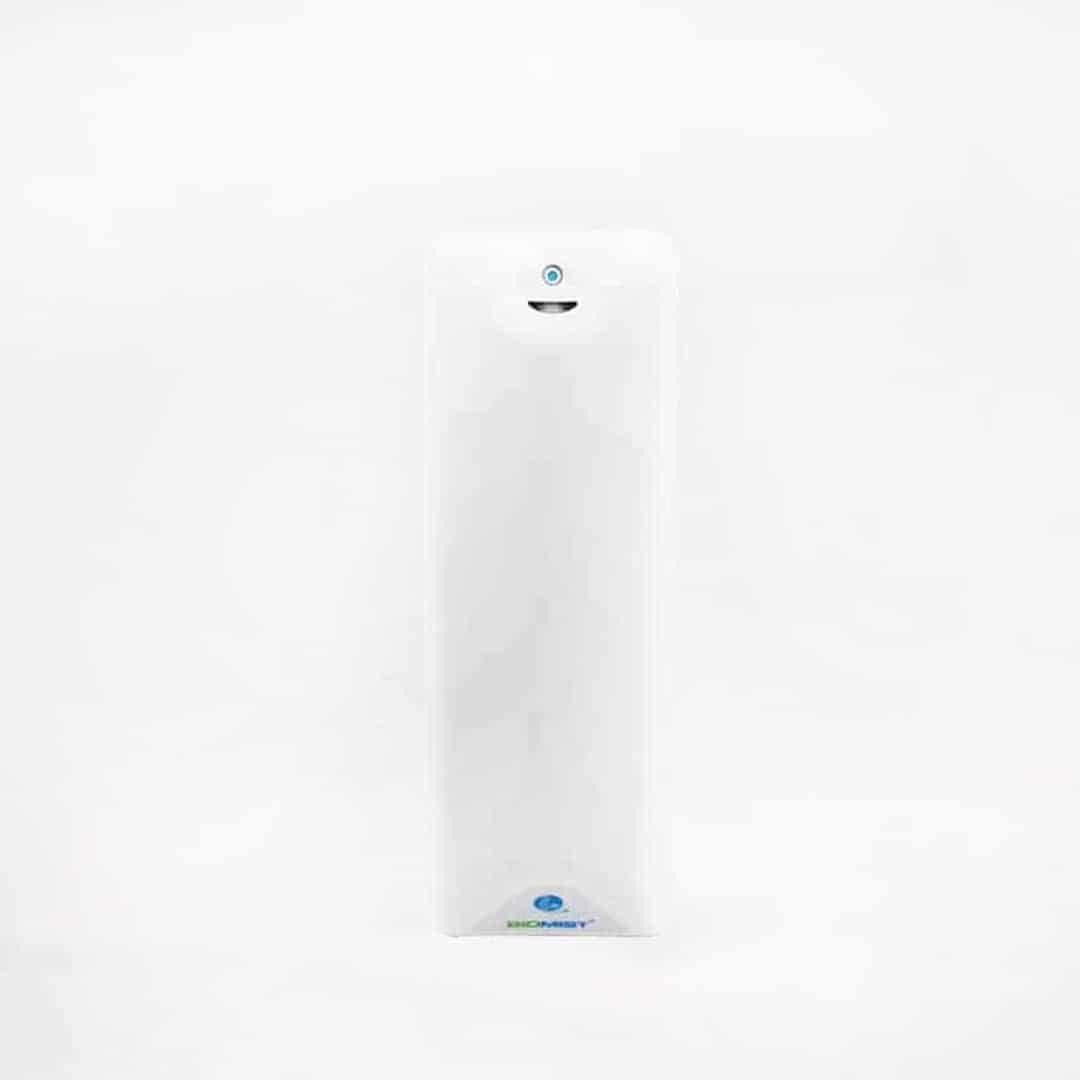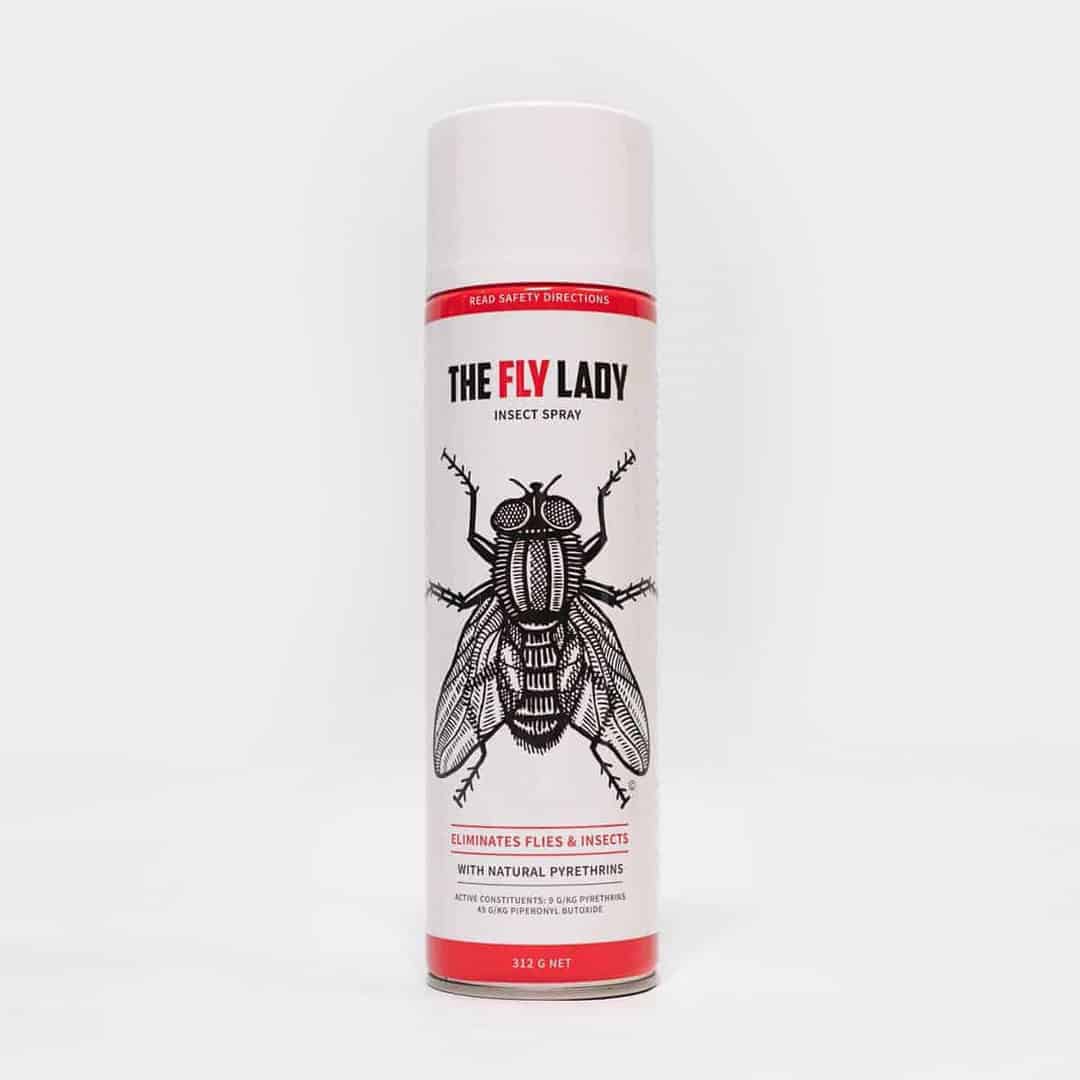How do restaurants keep flies out of food prep spaces and away from customers?
In Australia and New Zealand, flies are the most concerning flying insect pest for all food businesses. Controlling flies in restaurants and food businesses is part of the mandatory Food Safety Standards set by Food Standards Australia and New Zealand. The question is, how to achieve food safe fly control? How do restaurants keep flies away?
Most restaurants will require fly control, particularly during the warmer months when flies are most active. There are many options for fly control, with different solutions suited to different environments. In the restaurant space, fly control must be food safe, quiet, unobtrusively and fragrance free. It should create an invisible barrier, keeping flies out and providing 24-hour protection. Protecting the dining experience you create for your customers, protecting your product and your reputation.
Effective fly control for most spaces will require about 15 minutes of maintenance, every 6 weeks.
For peace of mind, you must eliminate flies from of your food spaces. Purchase food safe fly control space sprayers or dispensers and food safe spray canisters to go in the dispensers here.
How to get rid of flies in a restaurant?
This article will touch on:
- Why we need fly control in restaurants?
- What constitutes a fly problem for restaurants?
- What kind of flies are a problem in Australian restaurants?
- How do flies find their way to restaurants?
- What attracts flies, once inside a restaurant?
- Outdoor fly control for restaurants – problem areas.
- Indoor fly control for restaurants – problem areas.
- Front of house
- Back of house
- Dry store
- How to get rid of flies in restaurants?
- DIY restaurant fly control.
Why do restaurants need fly control?
Flies are:
- Extremely mobile, invasive and prone to feeding on waste and animal poop.
- Highly attracted to a variety of food products and food odours.
Flies:
- Carry organisms which may deposit in foodstuffs, transmitting disease and causing spoilage.
- End up in food, causing contamination.
- Lay eggs in food products, in both bulk ingredients and finished goods.
- Eggs may hatch into larvae which feed on, spoil and contaminate food.
- May move from garbage bins or animal poo onto food that will be consumed, uncooked by humans.
- Are contrary to food regulations and give the impression of poor hygiene.
- Damage reputations.
What constitutes a fly problem for a restaurant?
If customers are swatting flies away or a fly lands in a wine glass, it is a problem. Flies sitting on food is never good. In the kitchen – back of house, flies landing on food prep surfaces is not ideal. The cloud of vinegar flies in a bar area, also an issue. In sensitive environments such as food preparation and storage areas, even small numbers of flies constitutes a problem.
The 3 groups of flies found in Australian restaurants.
Australia has more than 30,000 species of flies. To date, only 6,400 of these have been officially identified. For the purpose of restaurant fly control, it is sufficient to divide flies into three groups – houseflies, blowflies and fermentation flies. All three groups are likely to be found wherever food is manufactured, prepared, served or consumed.
How do flies contaminate food?
All adult flies ingest liquid food only. When they land on a food source, they produce large quantities of saliva and regurgitated gut content. This mixture is rich in digestive enzymes. It is vomited onto the food together with any living bacteria and viruses present in the gut. The resulting liquid food is then sucked back up. This process may be repeated several times during which time the fly may defecate to reduce the overall body weight in readiness for flight. This feeding process underpins the principal mode of food contamination and spoilage by flies.
The life cycle of a fly
The life cycle of a fly consists of 4 stages. The duration of each stage is dependent on temperature and availability of food and water.

Flies lay eggs with hatch into maggots after approximately 15 hours. Maggots eat and store energy for pupation. They feed for about five days then find a dry, dark location to develop into an adult fly. Development time for each species will vary. Temperature variations will affect development times. Note: some species of blowflies lay live larva rather than eggs.
Generations per year
In ideal conditions, a fly can complete a life cycle in 7-10 days. In cooler conditions, the same cycle may require up to 2 months. In the cooler Southern states of Australia, 10-12 generations occur each year. In the warmer regions, flies may progress 20 generations per year.
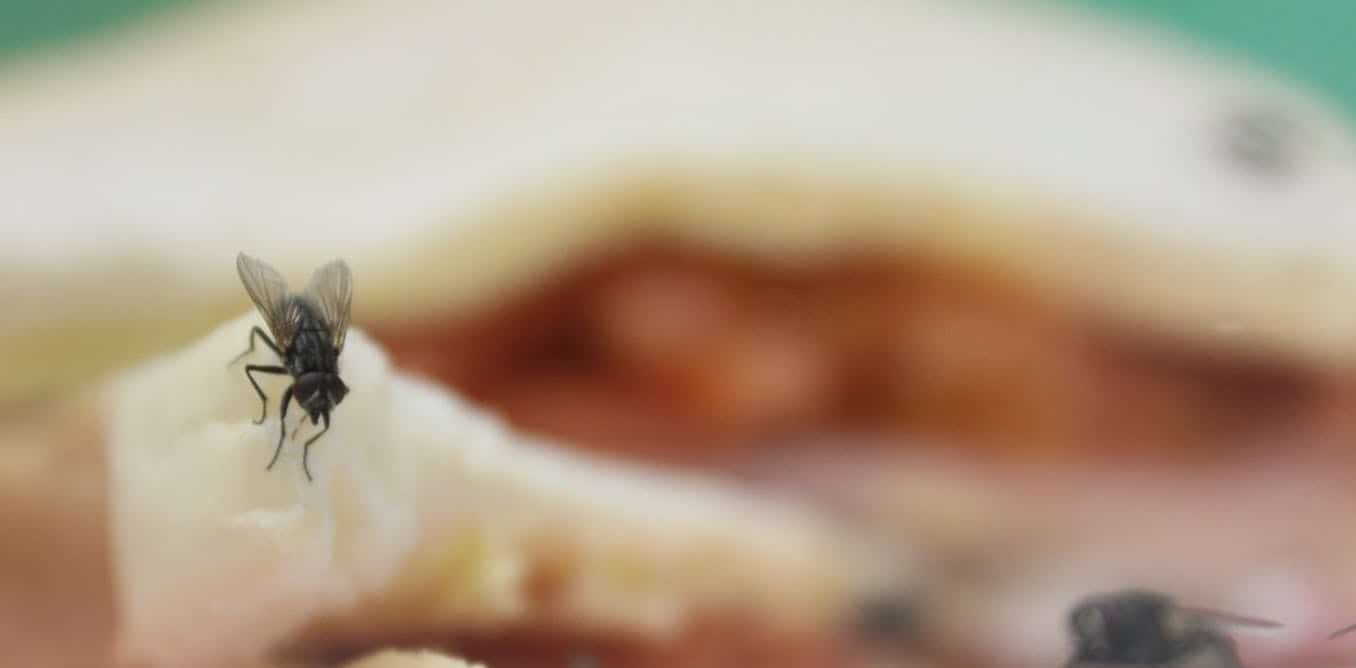
Flies found in Australian restaurants
Group 1. Blowflies
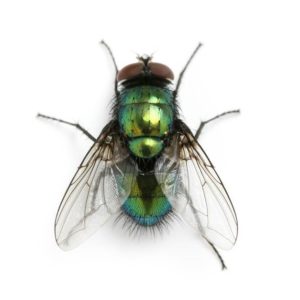
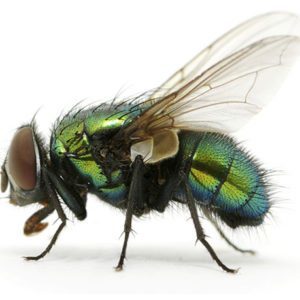
The name blowfly refers to any flies of the family Calliphoridae.
Included in this family are the common Bluebottle flies.
Name: Bluebottle Fly. Family Calliphoridae
Any of various blowflies that have an iridescent metallic blue, green or copper body.
Size: 9-13 mm
Attracted to: Rubbish bins, pet droppings and dead animals. Prefer to breed in meat-based materials. The incidence of blowflies is determined by the availability of animal material. This may take the form of exposed human protein food, food waste or dead animals – even very small ones like garden snails or other insects.
In nature, blowflies have an important role in aiding the breakdown of animal tissue and recycling nutrients back into the soil. Blowflies share most of the features of their biology with the houseflies but there are some important differences.
For example: All blowflies prefer a protein-rich breeding medium such as animal droppings, animal food, food waste, meat, dead and even live animals. Maggots found in exposed meat or animal carcasses are almost always from a blowfly species.
A few species of blowflies notably flesh fly (Sarcophagid) and some Calliphora species, larviposit. This means they lay live larvae rather than eggs. This can be a particular problem for food businesses.
Group 2. House Flies
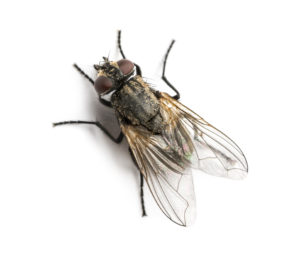
The name house fly refers to any flies of the family Musca domestica.
Name: Common Housefly
Size: 6-8 mm
Features: Lays 120 to 150 eggs per batch. Indoors they will rest on walls, floors, and ceilings. Outside they will rest on plants, fences, compost heaps and bins. At night they will rest near food source. Preferred resting height is 1.5 – 2 metres from the ground.
Attracted to: Food, including human and pet food, animal feed, food waste and droppings.
The common housefly has achieved a special prominence because of its ability to adapt to and cause havoc within the human environment. In addition, most of the significant health and pest management issues relating to the flies are exemplified in this species.
In nature, houseflies have an important role in aiding the breakdown of plant material. Housefly adults prefer to breed in warm, moist, decaying vegetable material, as can be found in animal poo, compost heaps and rubbish.
Adults are nectar and ‘wet-waste’ feeders and need a protein food component to mate and develop eggs. Feeding is a constant activity in warm conditions and the highly mobile and inquisitive flies may visit several separate feeding sites in the space of a few minutes, guided by their extremely sensitive odour receptors.
Copulation occurs only once per female, which then oviposits (lays eggs) principally in decaying vegetable material where the eggs hatch into larvae which feed and then pupate nearby in soil or dry vegetable matter.
Adult flies are often attracted to the general vicinity of premises by an abundant food source such as flowering plants or rubbish. They are then attracted inside by other odours and favourable conditions such as a moderate temperature and high humidity. They are extremely well equipped with sensory receptors used to detect favourable conditions.
Houseflies are found in virtually every human habitat. Abundance is controlled largely by climatic and microclimatic conditions, hygiene and sanitation practices and availability of food. In warm climates, adult flies are free ranging throughout the year and populations are continuous. Where winters are cold, overwintering may occur, or populations may be restricted to within warm locations like animal rearing facilities.
For more information on the house fly, click here.
Bush Fly
Name: Bush Fly (Musca vetustissima)
Size: 2-6mm
Features: Lay eggs in droppings
Attracted to: Large animals including horse, cows, and humans. Hang around for hours at a time attracted to sweat, tears, saliva and droppings. Transmit infections, especially eye infections. More common in rural areas.
Group 3. Fermentation Flies
Vinegar Fly
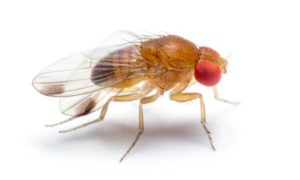
Name: Vinegar Fly (Drosophila melanogaster)
Size: 3-4 mm
Features: Life cycle is under two weeks in warmer climates. More studies have been conducted concerning the genetics of the vinegar fly than any other animal due to their easy breeding and short life cycle.
Attracted to: The Vinegar Fly feeds on yeasts and bacteria associated with rotting fruit and fermenting plant juice, not the fruit itself. They are a common nuisance pest in restaurants, grocery stores, fruit markets, canneries and around the home fruit bowl.
The larvae feed primarily on the yeast found in fermenting, liquefying items. Over-ripe tomatoes and bananas are commonly infested, as are rotting potatoes and onions. The liquid that remains in the bottom of beer cans held for recycling can also support vinegar fly larvae. Vinegar flies like the liquid in garbage containers, over-ripe fruit, some vegetables, used drink bottles, spills and moisture found in cracks in wet floors and below bar areas.
They will breed in any soured, decaying substance such as wet mop and broom heads and dirty linen baskets. In accumulations of food particles behind or under kitchen equipment and drains which have a gelatinous growth of scum. This is trigger and sufficient to support an infestation of vinegar flies.
Larvae typically pupate outside of the food source after feeding for up to a week. The adult flies emerge in several days and become sexually active within two days. The entire life cycle can be completed in as little as eight days at 29°C.
Elimination of breeding sites is paramount. Although insecticidal fogs and sprays will kill adult vinegar flies, the larvae will continue to develop, and new adults will emerge unless potential food sources are discovered and removed. Using automated aerosol dispensers, zip tied below the bar over beer taps drains will eliminate many of the vinegar flies sources of moisture and food.
During the summer months, adult flies may be attracted inside, toward light shining through windows. Because of the adult’s small size, they can gain access through standard window screening. Installation of 16 mesh (16 x 16 strands per standard inch) or finer screening is recommended.
For more info on vinegar flies click here.
Fruit Fly
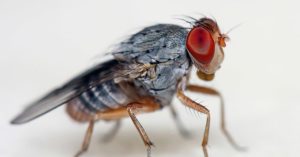
Name: Fruit Fly (Tephritidae family)
Fruit flies are a family, Tephritidae, containing about 5,000 species of often strikingly coloured insects.
In Australia, we have the Mediterranean Fruit Fly on the West Coast and the native Queensland Fruit Fly on the East Coast. Tasmania and South Australia are Fruit Fly free. Click here to read the article about the difference between the fruit and the vinegar fly from the Tasmanian Examiner Newspaper.
Size: 5-7mm
Features: Like to hover. Female lays up to 500 eggs. Mature to adults in 7 days. 3-week life span.
Fruit flies will sometimes breed in garbage but are rarely found in hospitality environments. Vinegar flies are often mistakenly identified as fruit flies.
Fruit flies are one of the world’s most destructive horticultural pests and pose risks to most commercial fruit and vegetable crops. They attack some 300 species of healthy fruit and above ground vegetables. For info on Fruit Flies from the Department of Agriculture, Water and Environment, click here.
Drain Fly
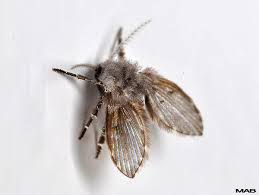
Name: Drain Fly (Psychodidae family)
Size: 2-3 mm
Features: Slower to mature, adult drain flies live for 8 to 25 days depending on temperature. Breeding only once, females will lay between 30 and 100 eggs. These eggs are laid just above the water line inside moist drains. Within 48 hours the eggs hatch into drain worms. The larvae feed on wet organic material accumulated in the drain. The larvae look similar to mosquito larvae.
Attracted to: Aquatic to wet sludge-based habitats. Sinks and drains, grease traps, wet mops and evaporation pans beneath appliances. Larvae can be found in wet soil. Its worth checking any indoor pot plants.
Drain flies are erratic fliers and often walk or run as well as taking flight. They are most active at night but may also be seen during daylight, near windows, lights or illuminated signage. Drain Flies are harmless but annoying.
When adults are found within a room, examine all drains for larvae. Because they are weak flyers, adults can often be found very near their development site.
The presence of adults in a drain or resting on walls near a drain is a sign that the drain is a development site. Flies may be developing in more than one drain, so inspected all drains.
Check drains by removing the drain plate and scraping the slime from the sides of the drain using a dull knife or similar device. Reach several inches into the open drain. Look for larvae within the collected slime. If larvae are not found in the slime that can be scraped from exposed drainpipes, it may be that moth flies are developing in organic material found deeper within the pipes. A more thorough assessment of drain fly development in the drain can be made using a trap.
The Trap.
Coat the inside of a cup or jar with vegetable oil and then invert the cup to cover the drain opening. Any drain flies emerging will stick to the inside of the trap. Traps should be placed over all drains in the room and left for 24 hours if possible. Examination of the traps will indicate which drains are development sites.
You can also place tape over the drain for 24 hours. The effect is similar. Remove tape and check for stuck flies.
Physical control is an integral part of eliminating drain flies. Removal of larval habitat is necessary. A common misconception is that pouring boiling water or bleach down a drain will control these flies. These treatments do not remove the organic film within the drain.
To remove the organic film within the drain, use a hard bristle brush with an industrial drain cleaner. Drains may need to be snaked first to clear any blockage causing slow draining and also to prevent further build-up of organic material within the drain. For sinks equipped with a J trap underneath, the trap should be removed and cleared of organic debris. Regular use of an enzymatic drain cleaner will help prevent the organic build-up.
Chemical control is generally considered unnecessary for drain fly management, as control will only be temporary unless larval development sites are located and removed. The application of The Fly Lady space sprays will provide immediate control of adult flies where sterility is an issue but should be combined with the removal of larval development sites. Insecticides may also be utilized when the flies are produced off-site or larval development sites cannot be eliminated. In some cases, combining the space spray with a residual pesticide applied to resting surfaces will provide a great result.
Fungus Gnat
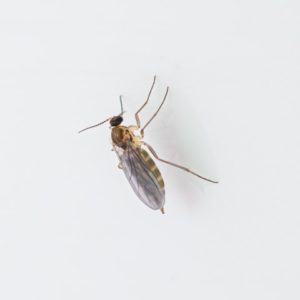
Name: Fungus Gnat (Sciaridae family)
Size: 1 – 4mm
Features: Most species are black, some brown. They have long thin legs and wings.
Fungus gnats breed in the soil, fungi, any place where suitable moulds grow. They are often found in indoor pot plants. When overwatered, mould in the soil provides a perfect medium these tiny flies.
Control of fungus gnats involves eliminating breeding sites by drying them out sufficiently to stop mould growth. Water pot plants less frequently. Cover pot plant soil with pebbles to stop gnats gaining accessing soil. (I have seen gnats coming in and out through the drainage holes around the base of plastic pots.) Leaks and damp should be dried thoroughly using fans if necessary. Wet, rotting wood or other such building materials needs replacing.
How do flies find their way to restaurants?
Great smells emanating from the kitchen.
Flies are attracted to smells. Any cooking smells emanating from extraction vents, rangehood outlets or wafting out of doors and windows will attract flies.
Flies can travel a surprisingly long way!
How far will they go?
Studies conducted at the University of Kentucky, using marked house flies, showed that 60% to 80% of flies were captured within 1.6km of their release point. Most of the rest, were caught within about 3.2km of the release site within the first 4 days after they were turned loose. A few flies have been shown to travel 8 to 32 km but these tend to be “record” individuals. In general, fly control efforts for a community problem are focused within 2km of the source. For the full details of the study click here.
Attractive sites.
Moisture and food, including lawn clippings, liquid waste, garbage and decaying organic matter provide a place for flies to feed and lay eggs. Naturally flies will tend to stay where their basic needs are met.
Tendency to disperse.
House flies seem to have an innate tendency to wander. Research has shown that some flies will leave a breeding site even though necessary resources are plentiful. Therefore, some dispersal will occur even when fly numbers are low. The more flies produced at a site, the more that will move away and become a problem to others in the neighbourhood.
Environmental conditions.
Optimum temperature and moisture will allow high fly production from even a minimal amount of breeding material. Winds will help with fly dispersal by allowing more flies to move longer distances than normal.
What are flies attracted to in a restaurant?
Once you are aware of what is attracting flies, you can begin working to prevent flies in your restaurant. Start by identifying and eliminating the sources that attract flies.
The fly control checklist outlines spots in a restaurant that are likely to attract flies and what can be done about it. Download the fly control checklist here. Print it off and hand it to the apprentice. She/he can use the list to identify the potential problem areas and report back.
Fly hot spots
Outdoor fly control
Bin and dumpster areas.
Ensure garbage bins emptied regularly. Twice weekly in hotter climates.
Rangehood exhausts and grease traps.
Footpath and council bins.
Garden beds.
Flowering plants.
Indoor fly control
Front of house.
Dining spaces.
Front windows.
Front counter spaces.
The pass.
Fruit & vegie displays.
Fruit juice blenders.
Coffee machines.
Bar areas
Bar runners.
Post mix taps.
Under bar spaces.
Beer overflow buckets.
Empty bottle receptacles.
Back of house
Food prep and kitchen space.
Dirty linen bags.
Broom, mop and dustpan storage areas.
Kitchen bins.
Kitchen floor mats.
Floor drains.
Dry storage areas
Stored product such as bags of flour.
Stored fruit and veg such as stone fruit, pineapples, bananas, onions and sweet potatoes.
How to eliminate flies in restaurants?
Fly traps, baits or sticky paper. No amount of gadgets or gizmos will eliminate a fly issue if your hygiene is not up to scratch. Having said that, many still experience fly issues despite having wonderfully clean kitchens. Customers may assume that flies indicate poor hygiene but that is not necessarily true. Quality hygiene practices will deny flies a reason to linger. They will still enter the premises, drawn by the smell of the food. Using a food safe, low dose aerosol spray will mean flies are forced to leave the area. It is a great option to control flies inside a restaurant. Purchase fly control spray here.
How to control flies in restaurants.
Inspecting for flies
Flies Adults: A localised congregation of adult flies often indicates the presence of a nearby breeding site.
Water: The larval food of flies must be moist. Thoroughly inspect all drainage channels and gully traps. When floors are washed, look for places where water is left. Under cookers, refrigerators, machinery, equipment of all kinds. In cracked or chipped tiles and damaged flooring. Dry mop floors to remove and left over moisture. Repair leaking or dripping equipment. Aim to eliminate their water sources. This will assist in the control of all kitchen pests.
Debris: Examine all possible locations where animal or vegetable waste tends to accumulate. Inspect under or behind machinery, equipment, pallets, in the bottom of lift shafts, and in bins and waste disposal areas. Check whether bins and dumpsters are clean, or if a wet residue is left on the sides and the bottom when emptied. Keep garden beds free of mulch and excess moisture. If using fertilisers, ensure they are well dug into the soil.
Marks: Favoured alighting surfaces can be identified by fly marks left on fluorescent lights, lampshades, windows and doorframes, picture rails, bulkheads, pipes, corners of walls and around fixtures in the ceiling.
Every effort must be made to eliminate breeding sites as well as food and water sources that enable fly populations to develop.
Indoor application of standard hygiene practices are particularly important for controlling flies.
These include:
- Adequate food hygiene practices in kitchen and restaurant areas.
- Food preparation areas, including floors, walls and equipment are cleaned and inspected regularly, including in cracks, crevices, and hidden spaces where traces of food and liquid can accumulate.
- Garbage containers are cleaned and can shut properly.
- All rubbish is disposed of in seal bags.
- Drains are cleaned to prevent the accumulation of moist sludge.
- Supplies are not brought in or stored in a rotting state.
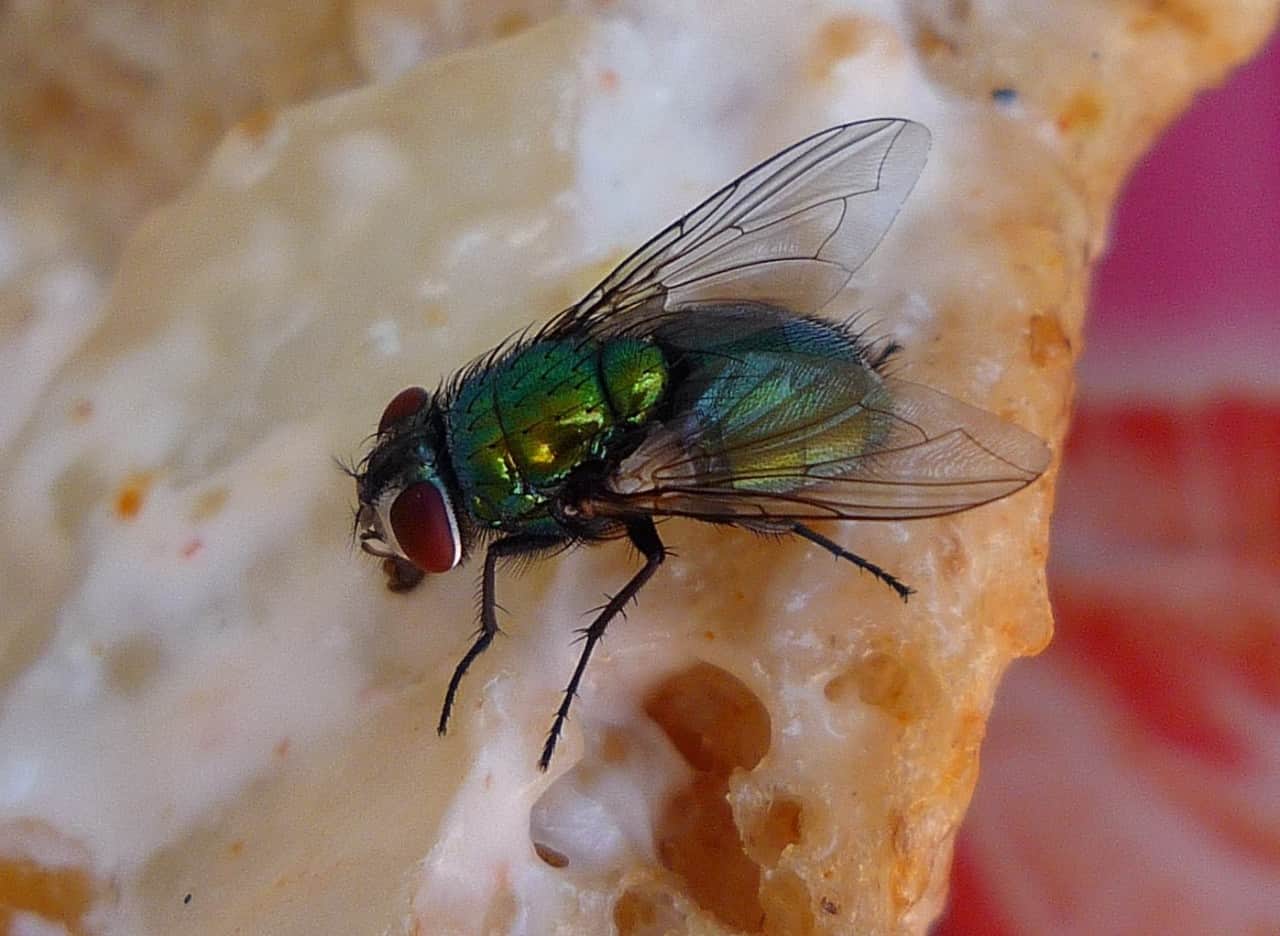
How to prevent flies in a restaurant.
Prevention is always easier than cure. A high level of cleanliness will deny flies the food and water they are seeking to support their feeding and breeding. A thorough, regular cleaning program should be followed. Be sure to include rangehood extraction filters, grease trap, floor drains, floor mats and mop heads. Aim is to create an environment that denies flies a reason to hang around.
Fly Screens
The number one solution.
Screen your kitchen’s back door and fit a spring loaded, self-closing hinge.
Ensure exhaust fans and ventilation outlets have insect mesh installed over the openings.
When doors are not completely sealed and gaps exist, flies may walk through the gaps to gain entry.
Ensure that all window and door screens fit correctly. Check for gaps around the edges of all screens. Ensure that seals on windows and doors are maintained and in good condition.
Install draft excluders along the bottom of doors to prevent flies and cockroaches walking inside, especially the back kitchen door.
Air-conditioning temperature and positive pressure.
Air-conditioning systems should provide a cool, low-odour environment, comfortable to humans, with a positive indoor pressure. A slight outward flow of air should be detectable when a door is partly opened. These conditions are relatively unattractive to flies.
Bag traps
Hanging disposable fly traps.
Fly Eater Bag traps attract flies to them. Keep this in mind and position well away from open doors, windows and customers. Hang traps in bin enclosures, around perimeter fences, near garden beds, dumpsters etc. Do not hang inside or near customer areas. Use traps to draw flies away from buildings and customer areas. For best results hang in full sun. Replace bag when it becomes full, to smelly or the attractant dries out.
Bait and bait stations
Tamper proof fly bait station to house fly bait. Use a fly bait station to stop wild life eating the fly bait and extend the life of the fly bait by protecting it from the weather.
Fly bait is best used in conjunction with a lockable fly bait station. The lockable station helps keep the bait away from native animals and extends the baits life span by protecting it from the weather. Fly bait is put into stations about the size of a mobile phone. Stations have 4 small trays to hold the bait. Flies enter via small vents in the front. They ingest the bait and die. Fly bait stations have several holes in the back panel. They can be zip tied onto wire fences or screwed onto timber. Fly bait is poisonous and must be handled according to manufacturer’s directions.
Use fly bait pellets in the bottom of dumpsters after emptying. Mix pellets with water to form a paste and paint inside bin lids and inside bin enclosure. Use fly bait stations in the bin enclosures, around premier fences and other out of the way areas.
Automatic fly control dispensers
Automatic fly control dispenser and food safe fly spray used in the dispenser.
Auto-spraying devices dispense a measured dose of aerosol insecticide. Spraying at 5 minute intervals fly control dispensers pack a big bang for your buck. An aerosol spray refill will dispensers fly control spray around the clock for 6 weeks before requiring a new refill. Automatic fly control dispensers are both effective and low maintenance. Only natural pyrethrum formulations should be used as these have low mammalian toxicity but are effective against flying insects. In the short term, these devices kill nearby insects but in the longer term, the aerosol is carried around the airspace and kills any insects which receive a lethal dose. The aerosol cans must be changed every 6 weeks and the batteries replaced annually. The maintenance time required per dispenser is 3 minutes every 6 weeks.
Install dispensers in internal areas of the food business where flying insect infestation has been experienced but not directly above food preparation and packaging areas. Note also, that dispensers should not be installed within 3 metres of any light trap as pyrethrum is repellent to insects and will affect the catch rate of the light trap.
As the fly control spray floats on the air, it is vital to consider the air flow when positioning automatic dispensers. If the product drifts straight out the door or window it will not be effective. Using automatic dispensers outdoors is not recommended for this reason. The spray will simply float away.
For large indoor spaces it can be easier to cover entry and exit points with automatic dispensers rather than trying to cover the whole indoor area. Some locations will wish to focus on trouble spots such as large sunny windows which can have a tendency to attract and trap flies, rubbish bin / mop / broom areas, kitchen areas where dirty dishes are stacked and plates are scrapped, front of house across the front of display cabinets, beside the back door where the deliveries come in. It will vary for each business.
View food safe fly control units installed in commercial food spaces by clicking this link.
Fly Fans
Fly control fan, ideal for use in close proximity to food.
Fly fans are great for use on service counters, beside the till, on the pass or inside food display cabinets. The hollographic markings on the soft blades scare flies away. Soft blades mean your staff cannot harm themselves if they accidently touch them. Fly fans are a food safe and non toxic. They take 1 x AA battery which if used constantly will last about a week (unfortunately they are quiet battery hungry) Some fly fans come with a power cord. For the sake of the environment l would recommend purchasing a fan with a power cord.
Residual sprays
Apply residual insecticide sprays to favoured resting places of adult flies. Use on table legs, backs of chairs, windowsills, the edges of bulk heads, suspended signage, fronts of service counters, under-side of shelves, the front of fruit and veg displays and refrigerated cabinets. Bin recesses, beneath bin lids. Spray placement will vary depending on whether your spray is food approved or not.
Fly sticky paper
Hang in broom closets, beside external doors. Keep out of view of customers and out of food prep areas.
Air curtains
Where entries or exits from food businesses must remain open, air curtains if correctly specified and installed, can provide a fast-moving airstream which should expel most flying insects which attempt to enter. Where appropriate, fit air curtains to building entry and exit points. Ensure that they are operating to specifications and that the airflow is directed outwards.
Strip curtains
Strip curtains can provide a physical barrier to deter flying insects which attempt to enter. Ensure that strips provide a continuous visual barrier to approaching insects when they are hanging motionless and that they are trimmed to ground level. Do not cut too short.
Things to consider before installing strip doors. They cut any breeze. They are hard to carry things through (ie trays of food) They can be fiddly to clean.
Various thickness and opacities available. They are relatively inexpensive and easy to install. Fly wire screen doors are generally preferable.
Fly lights
Ultraviolet light attracts flies and the glue board traps them. They require a power point or electrician to install. UV traps have difficulty competing with sunshine. They are most effective in areas of low light or when room lights are switched off. Research shows that flies respond to a U.V. light from 6 to 7 metres away. Accordingly, position lights at 12 to 14 metre intervals. Light traps cannot be placed within 2 meters of food preparation areas.
Maintained includes monthly replacement of adhesive boards and shatterproof UV tubes as per manufacturer’s instructions. Position units to draw insects away from sensitive areas and food products.
Electrocution traps must not be installed in food preparation areas.
For a chat about your restaurant or food business fly control, contact Pip – The Fly Lady.
FAQs
What is the best fly control solution for restaurants?
Food Safe Fly Lady dispensers provide a quiet, unobtrusive solution to fly problems. Creating a barrier to keep flies out and providing 24-hour protection. No electrician required. Ideal for sensitive hospitality spaces.
How do l know when l have a fly problem in my restaurant?
In sensitive environments such as food preparation and storage areas, even small numbers of flies constitute an issue. If customers are swatting flies away, there is a problem.
What type of fly is in my restaurant?
Flies found in Australian restaurants can be broadly divided into 3 categories – houseflies, blowflies, and fermentation flies. While being attracted to different things luckily, they can all repelled with the one product.
Why are flies attracted to restaurants?
Flies follow their noses to find their food sources. Great smells emanating from the kitchen, a plate of food taken to the customer, the garbage bins out the back. All smells like food to a fly. Moisture is also a basic need for a fly. In the countryside, when its dry, flies will go for stock, pets and humans to get moisture from the eyes, mouth, noise wherever they can. Decomposing lawn clippings provide moisture. Restaurants provide lots of opportunities for flies to access moisture.
How do l fix a fly problem?
Start by tackle the garbage bins. Flies come from outside – possibly just outside your back door.
Treat the inside of your bin lid with a paint on, fly bait. Assuming your bin lid is kept closed (a closed bin lid is standard fly control stuff) the product on the inside of lid will be protected from the weather and be able to do its job for longer. That’s what l like to call a flying start.
Does fly control work?
Yes. Automatic dispensers spray micro particles that stay suspended in the air. The Fly Lady spray contains naturally occurring pytherin, that insects are unable to metabolise. It is not a fast knock down spray. Flies will not die in your prep or in front of your customers. They will, however, be forced to leave the area.
How fast do flies breed?
In ideal conditions, house fly completes a life cycle in 7-10 days. In cooler conditions, the same cycle may require up to 2 months. In the cooler Southern states of Australia, 10-12 generations occur each year. In the warmer regions, flies may progress 20 generations per year.
What is the difference between a vinegar fly and a fruit fly?
Vinegar Flies feed on yeasts and bacteria associated with rotting fruit and fermenting plant juice. They are a common nuisance pest in restaurants, grocery stores, fruit markets, canneries and fruit juice bars.
Fruit flies feed on 300 species of healthy fruit and above ground vegetables. They are one of the world’s most destructive horticultural pests and pose risks to most commercial fruit and vegetable crops. It is particularly important to prevent Queensland fruit fly and Mediterranean fruit fly (found in WA) from spreading to South Australia and Tasmania, which are currently fruit fly free.
Can I DIY restaurant fly control?
There are lots of thing you can do in a restaurant to knock out flies. DIY restaurant fly control is possible. Download the restaurant fly control checklist here. It will walk you through identifying the potential hotspots in and around your restaurant. Print it off and give it to your apprentice. Fly control like everything in hospitality, is a team sport. You need all your staff onboard to effectively manage fly control. Everyone needs to do their bit in their area. Use the check list to get started.
The Fly Lady offers a fly control management system to take the pain out of fly control. You can assign fly control to any member of your staff and they will be guided and reminded of tasks, and when to perform them. It couldn’t be simpler.
Where can l get help with fly control?
The Fly Lady offers tailored fly control solutions specifically for the hospitality industry. Now specialising in restaurant fly control, The Fly Lady was a chef in Melbourne for 15 years prior to establishing her fly control business in 2009. Get fly control help from someone who knows commercial kitchens.
